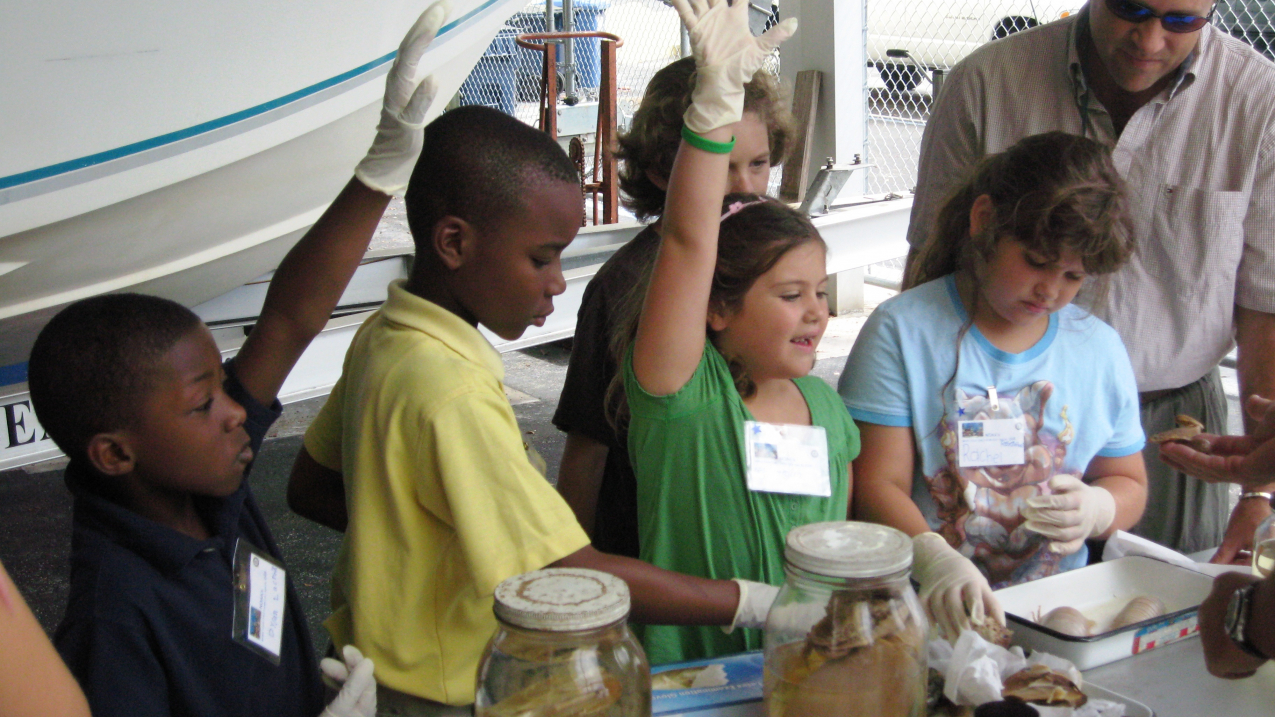Need a quick activity for earth science education? Below are hands-on activities that can be done in 15-30 minutes that get students thinking about how things really work.

Summer campers investigate marine life with the help of NOAA staff. (Image credit: NOAA - J Schull)
A drop in your hand: Water stewardship
See the relative volume of water available that is clean, safe, and available to drink.
Art activities
Looking for a creative outlet? Sharpen your colored pencils, grab your favorite markers, or dip into your paint palettes with these coloring pages and art contests from NOAA programs!
Boat building challenge
Use aluminum foil to make boats and then test designs by seeing how many pennies or paperclips they can hold.
Cooking up a storm: Atmospheric science in your kitchen
Brush up on your meteorology with these tasty, try-this-at-home activities ... along with one "maybe-don’t-try-this at home!" We’re headed to the kitchen to answer your burning questions: What’s the dew point of your leftovers? Why do some seasonings appear to defy gravy — uh — gravity? From convection to condensation, these kitchen science demos are sure to give you some food for thought.
How does sea foam form?
In this hands-on activity, shake up some frothy milk to model what happens when sea foam forms.
How marine mammals stay warm
Wear a “blubber glove” and plunge your hand into an ice water bath to investigate the insulative properties of blubber.
Hydrographic surveying: Mapping the sea floor
Hydrographic surveying is a scientific career that many people may not know about. In this activity, a sealed shoe box with a varied topography made out of clay will be measured by taking depth “soundings” with a skewer.
Ocean acidification and dry ice
Explore the chemical reaction between frozen carbon dioxide (dry ice) and water and compare this to changes that are occurring in ocean ecosystems, as excess carbon dioxide in the atmosphere is absorbed by the ocean.
Ocean motion: Wind-driven currents
Model the flow of ocean surface currents by blowing air across a tub of rheoscopic fluid and water, with clay structures simulating coastlines, islands, and sea floor features.
Oceanography in a mug
When it’s cold outside, there’s nothing cozier than a warm mug of cocoa, some spiced cider, or a steaming cup of your favorite tea. But here at NOAA, we always have Earth science on the brain. As we settled down to relax with our warm winter drinks, our inner oceanographers couldn’t help but think, hey, that looks familiar! These five activities show important principles of oceanography using delicious drinks and some household materials.
Plate tectonics and lava lamps
Use discovery and inquiry techniques to investigate a lava lamp and relate it to Earth’s internal processes that cause geological phenomena such as earthquakes, mountain building and sea-floor trenches.
Tying science to history: Making rope by hand
Participants will make cordage (rope) from fiber. This activity can be used to explore the development of technology as it relates to rope making, cables in suspension bridges, and the role of ropes in the maritime and fisheries industries.
Weather-themed printable items
Download, print, and share these free weather education resources.
Cool catch matching game
In this memory game students will examine photographs taken on a NOAA research ship to discover the diversity of organisms found in the Atlantic Ocean.
Fins, tails, and scales: Identifying Great Lakes fish offsite link
Working with a set of illustrated Great Lakes fish cards, students identify distinguishing characteristics of fish and use a dichotomous key to identify 10 common fish families.


